Content
- Maternity compression knee socks and stockings
- Why do you need compression stockings
- The reasons for the development of varicose veins in pregnant women
- Special models of stockings for women in labor
- Does everyone need compression stockings during pregnancy
- Contraindications for wearing compression stockings
- When to wear generic stockings
- How many days to wear compression stockings after surgery
- What is the difference between hospital stockings for childbirth and anti-varicose
- The difference between anti-embolic stockings and compression stockings
- Difference of standard compression garments
- What Compression Classes Mean
- Preventive (grade 0)
- Compression class 1
- Compression class 2
- Compression class 3 and 4
- How to put on and take off compression stockings
- Preparing to put on compression stockings
- Stages of donning
- Video: How to wear compression stockings, tights?
- How to remove compression garments
- Special donning devices
- Glider
- Butler
- Compression hosiery care
- 7 tips for choosing compression stockings
- How to choose the size of compression stockings for childbirth
- What to choose: open or closed toe (toe)
- What compression stockings to choose
- Ergoforma anti-embolic (hospital) stockings
- Anti-embolic stockings "INTEX"
Maternity compression knee socks and stockings
Even if you have never suffered from varicose veins and other diseases of the veins, keep in mind: ALL pregnant women have an increased load on the vessels, which can cause these diseases. Wearing special products made of compression hosiery (stockings and tights) is the best way to prevent them. It is necessary to start wearing compression stockings from the 2nd trimester, when the weight of the fetus is already high.
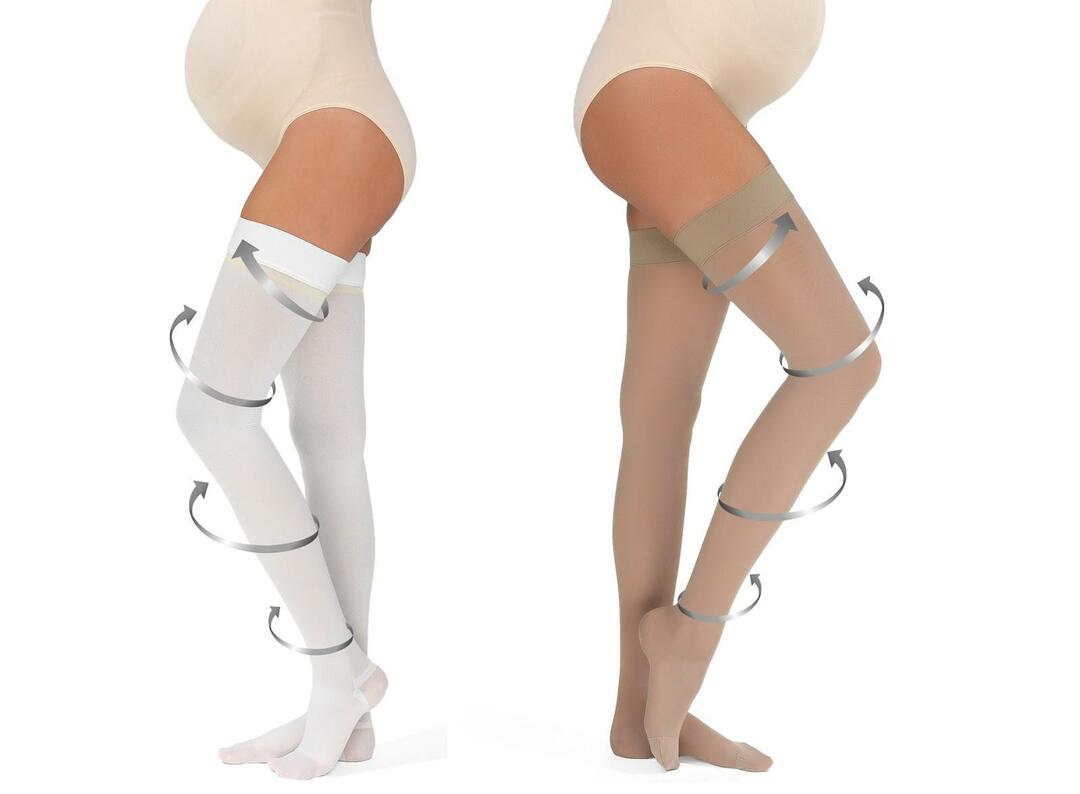
There is an opinion that compression stockings should be taken to the hospital only for those who will have a caesarean section. This is not true: during delivery in any way, the risk of vascular thrombosis increases due to prolonged lying position. Compression stockings are a must-have item on the list of things to take for childbirth.
Why do you need compression stockings
Stockings create unequal compression in different areas of the lower extremities: maximum - on the ankles, minimum - on the thighs. Thus, conditions are created for blood flow from bottom to top - to the thigh.
Compression Stockings Functions:
- prevention of edema;
- support of the walls of the veins;
- prevention of blood clots;
- stimulation of venous outflow;
- avoidance of excessive stretching of the veins.
For the selection of compression stockings, tights or socks, you need to contact a phlebologist. The doctor will take into account the available indications and select the product of the right size and class.
The reasons for the development of varicose veins in pregnant women
During pregnancy, the heart and circulatory system of the expectant mother are under great stress, since another circle of blood circulation is formed in the woman's body for the blood supply to the fetus. This leads to poor functioning of the venous valves and stagnation of blood at the lowest point - in the legs.
The stress on the heart and blood vessels is not the only factor that provokes varicose veins. In pregnant women, the uterus greatly increases in size. Its volume can be up to 10 liters. The weight of the fetus and amniotic fluid makes the uterus very heavy. As a result, this organ compresses other tissues, including the inferior vena cava, which leads to vasodilation, the appearance of edema and the vascular network. In difficult cases, the expectant mother may develop thrombosis. Therefore, the gynecologist observing the woman must explain to her what the compression stockings for pregnant women are for and how to choose them correctly in the store.
Special models of stockings for women in labor
All compression stockings for childbirth have certain characteristics in common: white or beige, so that the doctor can see immediately bruising (if any), and an open toe or hole in the foot, which allows you to assess the state of the blood supply to the limb by color skin.
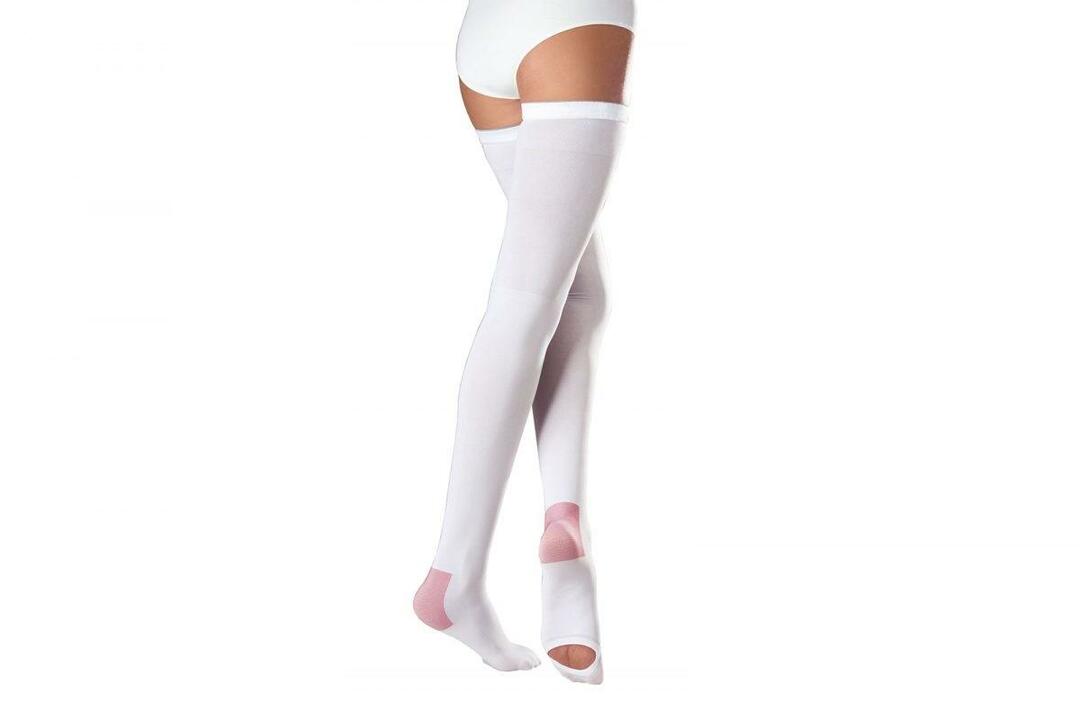
In addition, there are special models of anti-embolic stockings designed for women in labor with individual needs:
- Stockings for a wide thigh. Models with an extended thigh for those with curvy hips.
- Hypoallergenic. Latex-free stockings, which can cause allergic reactions (eg dermatitis).
- Antimicrobial. Thanks to the weaving of silver thread, the fabric of such stockings prevents the growth of pathogenic microorganisms that can cause skin irritation, an unpleasant odor, etc.
Does everyone need compression stockings during pregnancy
We will recommend that a woman wear compression stockings during pregnancy in the following cases:
- if we see her predisposition to problems with veins;
- if the expectant mother says that in the previous pregnancy she suffered from edema and noticed vascular networks;
- if the patient had such a problem as venous enlargement in the family;
- if a woman has high risks of complicated pregnancy (for example, hypertension, arterial hypertension, impaired fat metabolism, that is, there is a pronounced predisposition to edema).
All these factors already predispose to aggravated blood coagulation. And during pregnancy, the risks increase significantly.
Compression stockings (of course, if they are correctly fitted) reduce stress on the legs and help to restore a feeling of lightness and comfort.
Contraindications for wearing compression stockings
- diabetes;
- any wounds on the skin of the legs;
- endarteritis;
- skin inflammation on the legs (dermatitis, eczema, etc.);
- arthritis of the joints of the legs;
- obliterating thromboangiitis and atherosclerosis of the veins of the legs;
- heart and pulmonary failure.
When to wear generic stockings
If the birth is natural, then it is better to put on compression hospital stockings with the onset of the first contractions. If childbirth is planned through a caesarean section, then the stockings are put on immediately before the operation, although in some situations the doctor prescribes wearing them 2-3 days before the expected birth child.
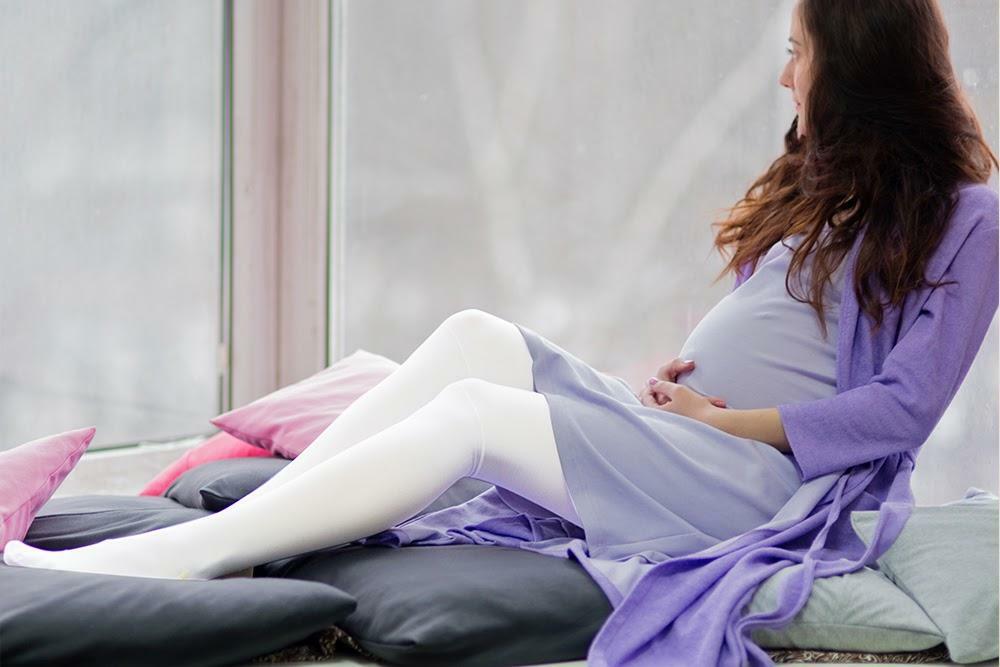
In some cases, when a woman is sure that childbirth is about to begin, stockings can be put on in advance, if the pregnant woman becomes calmer from the thought that she is already fully prepared to give birth.
How many days to wear compression stockings after surgery
Compression products must be worn during the operation, but if there is evidence from the attending physician, then after the operation, including the cesarean section, you must continue to wear stockings. The patient herself decides, taking into account her condition and characteristics, how much to wear them after the operation. If it is expected for a long time, then you will have to choose another pair or two ordinary compression stockings, observing the size, color and convenience. But if you do not intend to wear compression for a long time, you can use the already purchased compression stockings.
What is the difference between hospital stockings for childbirth and anti-varicose
In general, it should be explained what are compression stockings intended for childbirth, and how they differ from the usual compression stockings prescribed for the treatment of varicose veins.
The main task of generic compression stockings is to prevent blood clots, the risk of which during childbirth, especially through a cesarean section, is very high due to vascular rupture and bleeding. To achieve this goal, hospital (medical) anti-embolic compression hosiery is used, which provides distributed (that is, uniform over the entire area) pressure on the tissues of the limb, thereby causing a narrowing of the venous lumen of the vessels and increased blood flow.
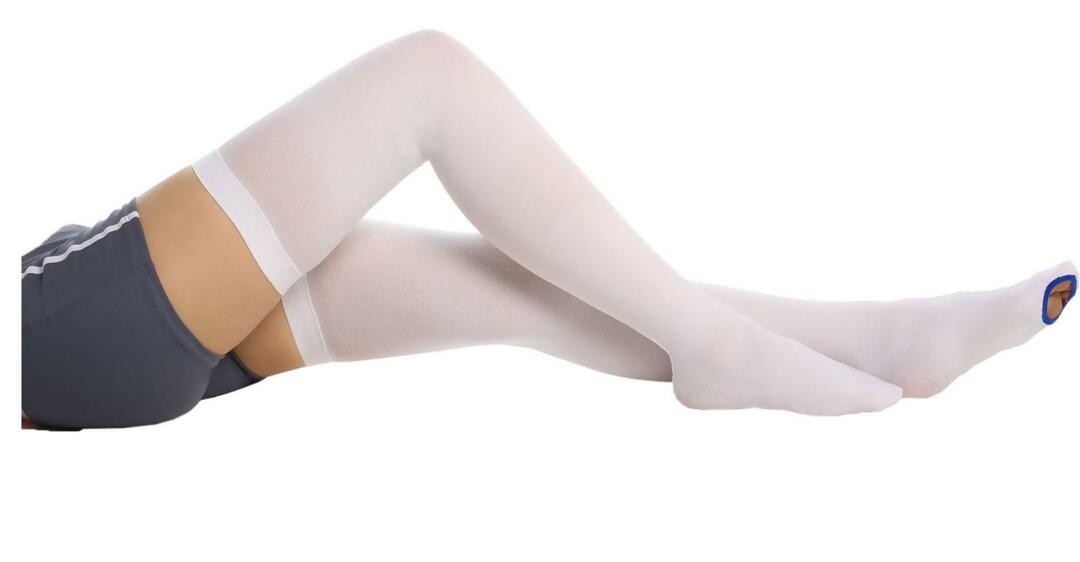
Due to the improvement of blood circulation and microcirculation in general, the woman in labor does not experience venous congestion or edema, which creates favorable conditions for the formation of blood clots or the development of varicose veins, which helps to solve the problem of vascular postpartum complications.
The main difference between stockings for childbirth and anti-varicose models is the above-mentioned distributed compression, while, how anti-varicose models create graduated compression - that is, maximum in the ankle area and minimum in the area hips.
Graduated compression is only necessary for the legs if they are in an upright position (standing or sitting) when the ankle veins are experiencing difficulties with blood supply, and the pressure difference between the bottom and the top of the limb helps to increase blood flow and thus restore nutrition fabrics. Uniform compression is shown for the limbs in their horizontal position (lying), when the force of gravity is not an obstacle for free outflow of blood, the leg veins are in a relaxed state and therefore there is no need somewhere to stimulate blood circulation more strongly, and somewhere less.
Due to this difference, birth stockings are prescribed only for bedridden patients - during childbirth and the postpartum period. In the future, when the woman in labor begins to get out of bed, hospital stockings can be replaced with conventional compression stockings, if the doctor deems it appropriate.
The difference between anti-embolic stockings and compression stockings
Unlike compression hosiery, antiembolic stockings are not designed to be worn regularly.
They are prescribed by a doctor to be worn during surgery, during childbirth, to speed up the rehabilitation process after injuries and operations.
As a preventive measure, anti-embolic jersey can be used in case of discomfort in the legs only on the recommendation of a doctor.
Difference of standard compression garments
Today, in the context of the development of the market industry, the complexity in choosing compression underwear is still added by a variety of manufacturers and standards. But a wide selection does not guarantee only a quality product. Experts suggest choosing knitwear according to the following standards:
- British Standard - BS: 6612; 1985;
- German Standard (German) - RAL-GZ 387; 1987;
- French Standard (French) - ASQUAL;
- A draft European Standard (European) - ENV 12718; 2001;
- USA Standard (USA).
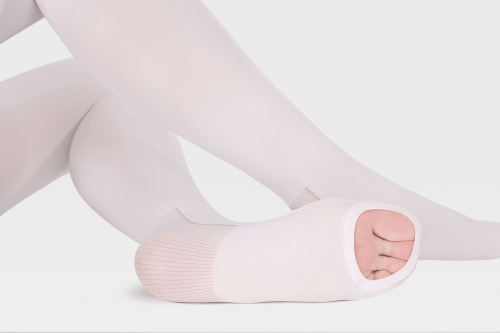
What Compression Classes Mean
The elastic material of medical jersey exerts a certain pressure on the legs - compression. According to this characteristic, all jersey medical products can be classified into four groups. This takes into account the pressure at the ankle.
Compression classes 3 and 4 are rarely prescribed for serious problems. It is almost impossible to put it on without special devices.
1 and 2 class of stockings, as well as prophylactic ones, are prescribed for pregnant women to wear permanently or during childbirth.
You can buy first-class and preventive products yourself, the rest of the medical jersey is prescribed only by a doctor.
Preventive (grade 0)
Distributes pressure 15-18 mm Hg. Art. Can be used without the prescription of a phlebologist. It is selected in order to prevent the appearance of varicose veins.
Compression class 1
Light compression ratio, 18-22 mm. rt. Art.
This class is allowed for pregnant women and women with the initial stage of varicose veins. Indications for wearing class 1 underwear: fatigue in the legs, burning sensation, the appearance of spider veins, genetic predisposition.
Compression class 2
Treatment class, 23-33 mm. rt. Art.
The indications for wearing this class are severe swelling, varicose nodes and severe varicose veins, night cramps, as well as a previous minor operation on this problem.
Compression class 3 and 4
They have a pressure of 34-45 mm Hg. The doctor prescribes the wearing of this type of jersey for deep vein thrombosis, trophic ulcer, severe venous insufficiency. The pressure on the legs is significant, because the third and fourth class jersey must be chosen especially carefully, and the doctor's prescriptions must be followed in full. Otherwise, it is naive to expect success in treatment.
Stockings of the fourth class, exert a pressure of more than 45 mm Hg. Art. They are part of therapy for extensive swelling of the legs and lymph drainage disorders.
How to put on and take off compression stockings
Even if the measurements are made correctly and the compression stockings are selected as accurately as possible, the desired effect may be absent. This is usually due to the fact that a person does not know how to put on stockings.
Preparing to put on compression stockings
High-quality medical anti-varicose jersey can properly serve up to six months with daily washing and wearing. In inept or inexperienced hands, it breaks in the first month. Prepare your arms and legs to prevent donning problems and extend product life.
- Remove jewelry from your fingers, including your wedding ring (if possible).
- Trim your nails carefully and file the edges.
- Dry the skin with a towel, do not wear with wet hands.
It is good if you have special gloves at hand (they can be included). Their embossed surface delicately but firmly grips the product and makes it easier to put on. In such gloves, it is easier to distribute the knitwear over the leg at the final stage. The skin of the legs also needs to be processed. Corns are smoothed, and a special spray is applied to the surface, which is sold in orthopedic salons. Its composition makes it easier to put on knitwear due to increased slip. Having prepared the legs and arms, you can start putting on the medical underwear. This is done while lying, standing or sitting, it all depends on the state of health, the devices used and convenience. If severe swelling appears on the legs, it is better to lie down for 10-15 minutes with raised legs before the procedure.
Stages of donning
This can be done manually in the following sequence:
- straighten the stocking;
- insert your hand inward to the heel, holding it in a fist;
- remove the seamy side out so that you get a small "pocket";
- insert your leg into the “pocket”, straighten the product and make sure that there is no twisting;
- gradually grabbing the fabric, pull the stocking up to the ankle, then distribute it over the lower leg and thigh;
- smooth the stocking with sliding movements.
If you can't put on the product with your hands, you can use special devices - a butler or a glider. You can learn more about how to put on stockings with and without devices in this article, where I talked in detail about 8 ways to put on stockings.
Video: How to wear compression stockings, tights?
How to remove compression garments
For prevention, it is recommended to wear tightening underwear for several hours (4-5 hours is enough). In the presence of varicose veins, its use is recommended throughout the day. The main thing is to take off stockings, knee-highs and tights at night so that the body can rest.
Instructions for removing compression garments:
- put rubber gloves on your hands for convenience;
- grab the top edge;
- remove carefully, as if turning the material inside out.
Pull-up stockings, knee-highs and tights are inconvenient to wear in summer and may not be worn this season. The exception is the presence of varicose veins and pregnancy, in this case, underwear must be worn, regardless of the season of the year.
Consult a phlebologist before wearing compression garments. He will prescribe a pattern for wearing it and give additional recommendations based on the condition of your legs.
Special donning devices
Even observing the technique, you can accidentally damage the product, so it is better to use special devices. They greatly facilitate and speed up the process. Among devices of this kind, the following are most popular: glider and butler.
Glider
In the set of some models with open toes, there are special footprints made of sliding fabric. With their help, you can cope with the task much easier and faster.
For knitwear with open toes
The process itself is almost the same as the self-donning method described above.
- Slip the sock onto your foot in a comfortable position for you.
- Turn the stocking inside out, and then, at heel level, wrap the sock inward. Make sure there are no creases.
- Insert your thumbs into the resulting "pocket" and stretch the product.
- Slip it over your foot so that the heel of the stocking is next to your heel. Make sure there is no heel movement to the side.
- Take a stocking in the middle of your foot and throw it over your heel. If the jersey fits the leg tightly and you can't grab it with your fingers, pull it from the inside of the bead with your other hand. Subsequent movements will be similar.
- Check that there are no wrinkles and that the distribution of the material is approximately the same throughout the limb.
- Pull the track through your open fingers.
Closed-toe jersey
In this case, the previous method will not work. Gliders of a different design are used here. There are sliding socks, for example from Venosan, which are equipped with an additional pocket. But it will be much easier to use the German Bauerfeind VenoTrain fixture.
Butler
Hospital
With limited joint mobility, it is difficult for a patient to put on compression hosiery on his own. We'll have to look for an assistant and it's good if he has a hospital butler designed just to help another person. It is a simple device with which you can complete a task in a matter of seconds. Procedure:
- Lower the stocking toe down between the two arcs of the butler.
- Pull the elastic over the arches and lower it to the base of the fixture.
- Gently pull the rest of the compression product onto the butler so that the heel is in the area of the top of the device.
- Put on the stretched stocking first on the patient's foot, then move the device further, through the ankle to the bottom of the knee.
- Carefully remove the structure, while the laundry should remain on the leg.
- Manually distribute the remainder.
- Spread the fabric so that there are no wrinkles.
With handles
In structure, this device is similar to the hospital version, but it has handles, thanks to which a person can put on compression stockings on their own. To do this correctly follow the instructions:
- Place the structure so that the semicircle of the frame is directed towards you with the back side.
- Spread out the stocking and place it in the butler so that the heel is facing you and the sock is away from you.
- Turn the compression product inside out at the top and slide it over the semicircle of the frame.
- Smoothly move the laundry to the base until the heel is turned inside out.
- Insert your leg into the stocking and push it down until your toes are resting on the toe.
- Make sure that the toe and heel of the product are not shifted to the sides, correct them if necessary.
- Place your foot on the floor and pull the compression product up to your knee, holding on to the handles.
- Take out the fixture and distribute the fabric by hand.
- Check for creases and creases.
Compression hosiery care
Stockings don't look like a durable product. And indeed - usually their service life does not exceed 12 months, and in many cases the laundry breaks and falls into disrepair even earlier.
What to do?
First of all, the stockings must be washed. Including jersey with antimicrobial protection. Remember - you wear elastic underwear all day and dead skin cells constantly accumulate on it. So wash it daily.
Best of all - by hand.
For washing, use baby soap or other delicate products that will not damage the knitwear. The laundry cannot be boiled.
After washing, squeeze the water out of the stockings very carefully. Do not stretch them or damage the fabric. You can wipe off moisture with a towel.
Dry the knitwear on a flat surface, only in cool or warm places, as high heat can destroy the material.
Even with proper care, stockings will sooner or later lose their elasticity. Sometimes after a few months. Less often - after a year.
How to change jersey on time?
The loss of elasticity is easy to notice in the morning when you put on your stockings. Old compression garments pull on very easily. Hence the conclusion - it no longer clasps the legs with the necessary strength and therefore it is necessary to buy a replacement.
7 tips for choosing compression stockings
Would you like to learn how to wear compression hosiery? We advise you to first decide on the correct selection of products. This is influenced by a number of factors.
- Decide on the purpose of use: prevention, treatment or stay in the postoperative period.
- Visit a doctor for the selection of the desired height of the product: tights, stockings, knee-highs, socks.
- Buy a compression device strictly according to the required compression class.
- Choose the size based on the table on the manufacturer's packaging. Before visiting the store in the morning, take measurements of the half-girths of the limbs: in the lower leg, under the knee, in the middle of the thigh, under the buttock.
- When choosing a brand, pay attention to brands with a reputation as a reliable manufacturer that has been in this field for a long time.
- Take a closer look at the quality of sewing: there should be no pronounced seams and joints, the material should look uniform in texture and color, and stretch perfectly.
- The final cost of products depends on the quality of the materials used, innovative techniques in creation and international certification.
How to choose the size of compression stockings for childbirth
- The effect of wearing compression hosiery will only be noticeable if you choose the right size. To do this, it is necessary to take measurements from the feet in the morning before the appearance of puffiness. You can take measurements yourself, but it is better if we do it by a phlebologist.
- Medical jersey is made in accordance with the standard size range. There are 3-7 sizes of compression garments. If many different anatomical parameters are indicated on the package, then it will not be difficult to choose the optimal size that will provide the best therapeutic effect.
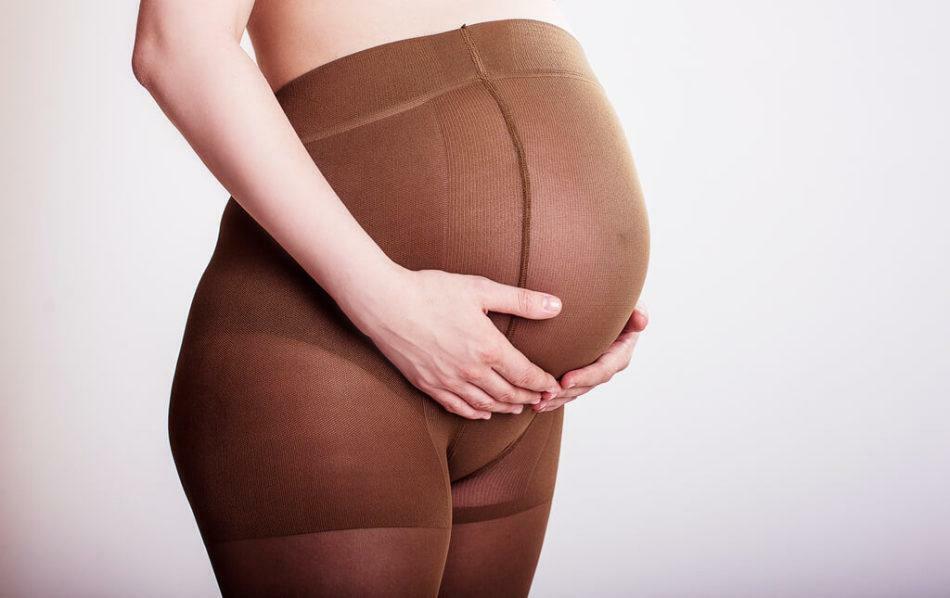
If many different anatomical parameters are indicated on the package, then it will not be difficult to choose the optimal size that will provide the best therapeutic effect.
- You should not trust specialists who are guided by the height and weight of a pregnant woman when choosing medical underwear. The pressure of the medical jersey is strictly dosed: when moving up to the thighs, it decreases. Therefore, when choosing compression hosiery, measurements such as thigh circumference (taken at a point located 5 cm below the gluteal fold), calf and ankle circumference, and foot size are necessary.
- For owners of thin legs with a foot size of 38-39, the S-size compression stockings recommended for owners of feet 34-36 cm will cause discomfort. In this case, it is better to purchase jersey with open toes.
What to choose: open or closed toe (toe)
Open-toed stockings are more comfortable for the operation, since through the hole in the toe the doctor will be able to evaluate the patient's condition, as well as weaken the compression, for example, in the ankle if the product compresses strongly leg. If the patient has large leg sizes, then an open toe on surgical products will also be preferable. An open heel is rare, as the absence of a heel will reduce the amount of pressure.
An open toe and heel is an interesting option, but then there will be no pressure on the heel, and the overall compression in the ankle area of the foot will decrease. This option is suitable in special cases on the recommendation of a doctor, and is associated with non-standard foot sizes.
Operating medical stockings are needed for everyone who is preparing for an operation, childbirth or cesarean. And for women in labor to keep the vessels on their legs during overload. If there are female prerequisites for varicose veins (after all, after wearing a heavy abdomen, veins in the legs often become visible) and for those who do not have them, so that this disease does not appear. After all, it is known that it is extremely difficult to recover from varicose veins, which means it is better to avoid it. During childbirth, no less pressure is exerted on the walls of the vessels than before. And this is dangerous with the formation of a blood clot and the consequences of its separation.
If you take into account all these tips, then your legs will easily transfer all the burdens in a medical institution, and after discharge they will be even more beautiful than before.
What compression stockings to choose
Below are high quality compression stockings that are suitable for women in labor.
Ergoforma anti-embolic (hospital) stockings
Ergoforma antiembolic stockings are suitable for use in the postoperative, postpartum period and in bed rest after strokes and heart attacks.
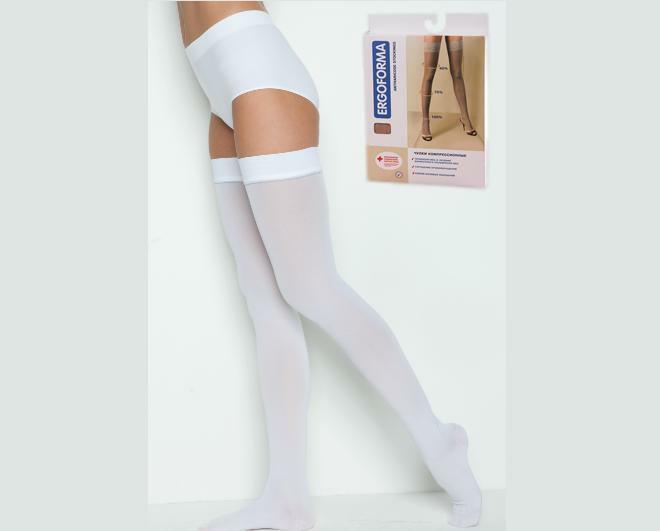
Features of Ergoforma products:
- contribute to the normalization of the outflow of venous blood due to graduated compression on the muscles and the venous wall;
- suitable for women and men;
- a wide silicone rubber band in the area of the upper third of the thigh does not exert excessive pressure, and the hole under the distal part of the foot promotes effective air and moisture exchange;
- a special hole under the fingers allows you to control the state of blood microcirculation.
Anti-embolic stockings "INTEX"
A specially developed technology for knitting products and the use of hollow threads allows you to effectively remove moisture from the skin, improve air exchange, facilitate skin respiration, which makes the wearing of knitwear to the maximum comfortable.
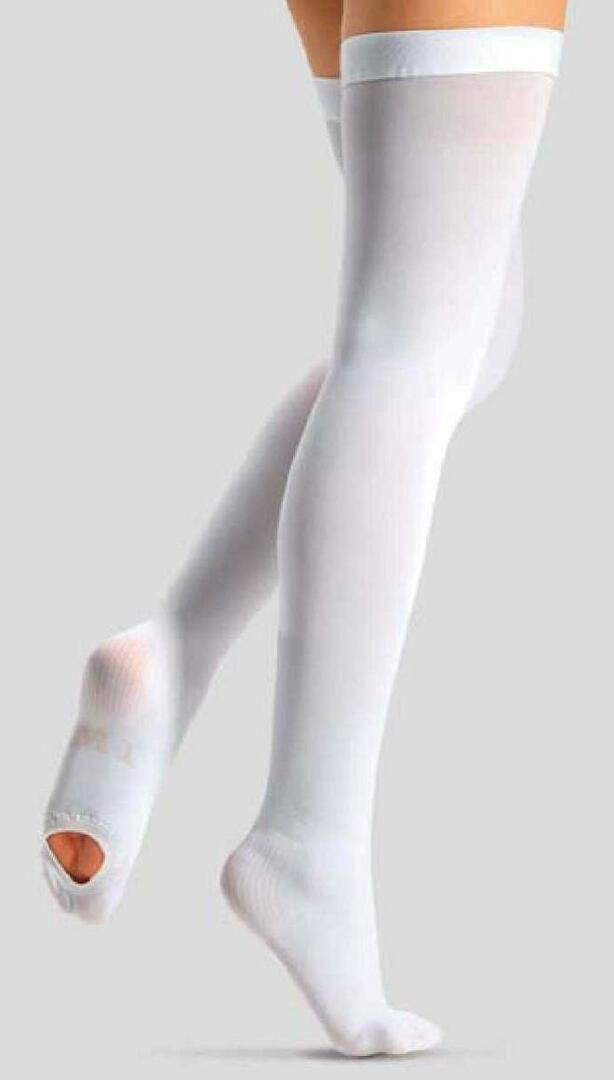
Benefits of INTEX antiembolic stockings:
- stockings "INTEX" are made using a special technology (with a hole in the toe of the stocking), which makes it easier to monitor the patient's condition during and after operations;
- products have an elastic band with a point application of silicone, for a secure fit on the leg;
- anti-embolic jersey "INTEX" is produced in accordance with the standard and is hypoallergenic;
- soft elastic band that does not interfere with blood flow;
- reinforced toe and heel parts increase the wear resistance of the product;
- silicone-based lace elastic decorates and gently fixes the stocking on the leg;
- beautiful appearance.
Sources of
- https://roddom.msk.ru/poleznoe/kompressionnye-chulki
- https://www.orto-s.ru/pokupatelyam_i_pacientam/dlya_chego_nuzhny_kompressionnye_chulki/
- https://filorosso.ru/poleznaya-informaciya/article_post/kompressionnye-golfy-i-chulki-dlya-beremennyh/
- https://www.netran.ru/articles/poleznaja-informacija/vse-o-kompressionnom-trikotazhe/kompressionnye-chulki-dlya-rodov/
- https://letidor.ru/zdorove/nuzhno-li-nosit-kompressionnye-chulki-vo-vremya-beremennosti-i-rodov.htm
- https://geomed-m.ru/o-belye/kompressionnye-chulki-na-operatsiju-rody-ili-kesarevo-kak-pravilno-vybrat-razmer-i-skolko-nosit-posle.html
- https://esculap.su/antiembolicheskie-chulki-vidy-primenenie-sovety-po-vyboru/
- https://vascul.ru/articles/compression-stockings-how-to-choose
- https://docpahomov.ru/stati/kompressionnyj-trikotazh/chulki
- https://docpahomov.ru/stati/kompressionnyj-trikotazh/vse-kompressionnyj-trikotazh
- https://docpahomov.ru/pamyatki/kak-nadet-kompressionnye-chulki
- https://heaclub.ru/chulki-kompressionnye-dlya-beremennyh-v-roddom-dlya-rodov-zachem-nuzhny-kak-pravilno-vybrat-razmer-dlya-chego-nuzhny-kompressionnye-chulki-posle-rodov-i-skolko-ih-nosit
- https://ortopedcentr.ru/articles/kak-nosit-kompressionnoe-belio/
- https://orto.salon/vybor-kompressionnyh-chulkov-pri-varikoze/
- https://orto-magnat.ru/clauses/kak-pravilno-odevat-i-nosit-kompressionnyy-trikota/
